Preamble:
My original plan was to re-post my review here tomorrow, but I'll go ahead and do it now before I forget about certain things I want to add to its title and preamble.
PS: Props to everyone who got the Doctor Who reference in the title of the
original review as well as this re-post's title.
So,
originally posted in English on my English and German audio review website, the "
Kopfhörer-Lounge", here comes my review of the Cowon Plenue J.
Without further ado, let's say "allons-y, Alonso"!
Introduction:
Here at the
Kopfhörer-Lounge, Cowon’s high-end digital audio player
Plenue 2 is in frequent use for reviews and also private listening. Reasons for that are not only its flagship-level transparency, easy to use, bug-free and intuitive user interface or beautiful design as well as high level of build quality, but also, and mainly, its low output impedance, excellent hiss performance and load stability, which makes it a fabulous choice for in-ears that place high demands on the source device, such as low-impedance multi-BA in-ears with a capricious impedance response.
However, the Plenue 2 is also a high-end flagship-level-quality player, which is reflected in
its price.
Flagship and summit-fi territory aside, Cowon have always offered more budget-friendly mid-priced digital audio players, too. Their core features have always been, at least for most models, good battery life, in-ear-friendly specs and performance, an easy to use and intuitive graphic user interface, and last but not least Cowon’s joker, the powerful yet easy to use and user-friendly JetEffect EQ and DSP integration.
The new, recently unveiled
Plenue J is also part of this category. It promises a compact, elegant design, 64 GB of internal memory plus one micro SD card slot, up to 53 hours of MP3 playback (and 27 hours of lossless 24 bit hi-res audio playback), in-ear-friendly specifications, 24 bit hi-res playback capability and as always, how could it be otherwise, an implementation of Cowon’s JetEffect (5) DSP and EQ software.
How does the
Plenue J perform? Let’s find it out in this very review!
Full disclosure:
I was provided with a free sample of the Cowon J for the purpose of an honest, unbiased test and review without any restrictions or requirements, no matter how it would turn out.
Technical Specifications:
Price: around
€299/$299

(Image source:
http://www.cowonglobal.com/product_wide/PLENUEJ/product_page_4.php)
Unboxing and Delivery Content:
The unboxing experience and delivery content is rather plain and nothing too spectacular. If you are already familiar with Cowon’s more recent devices, it won’t be anything really new, either.
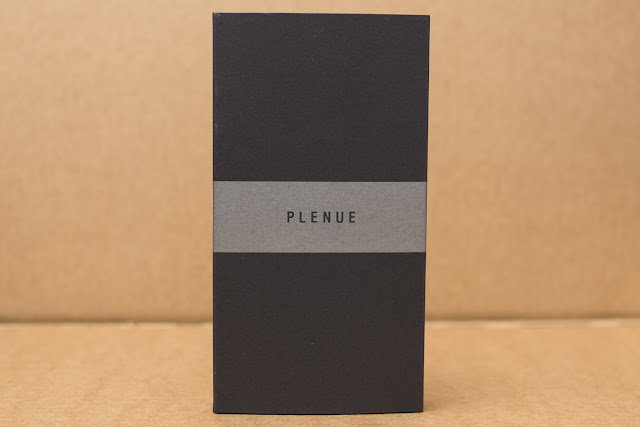
What you get is a black cardboard box with a black cardboard sleeve, both with Cowon labelling.
Inside, one can find two smaller boxes, each containing the player respectively the charging/data cable. A dust plug dummy for the micro SD slot is already mounted, too.
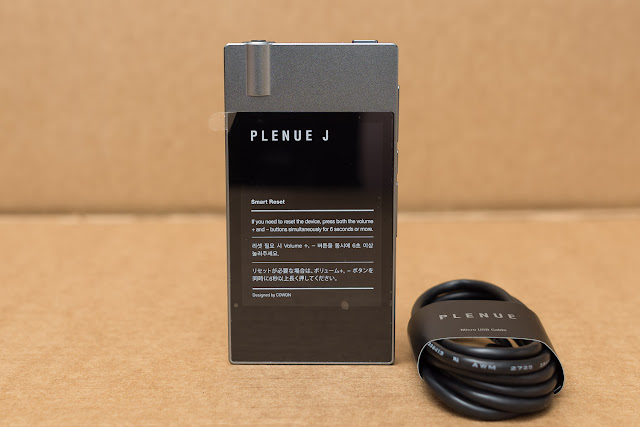 The optional Screen Protector and Leather Case:
The optional Screen Protector and Leather Case:
Just like for most of their digital audio players, Cowon also offers an optional screen protector and leather case.
Upon opening the shipping box, I was positively surprised that they had also sent me both accessories, likely with the intention to use them in my review, so yeah, why not, I’ll do it.
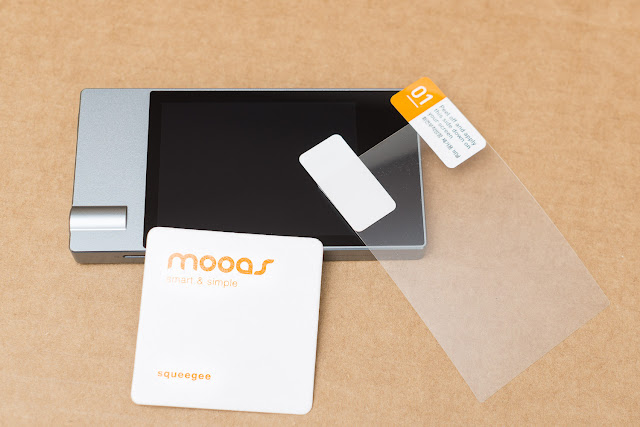
Regarding the screen protector (that comes with a microfiber cloth and a cardboard squeegee), I’ll make it short. It’s a fairly standard screen protector foil that is easy to apply if you do it directly after removing the protective film that is on the player when it arrives.
Personally, I would however get a smartphone screen protector for cheap, cut it to the right size (or get a screen protector with the same size in the first place) and apply it to the screen. Although it won’t save you much money, I don’t really see an advantage of the official screen protector over just any other cheaper one.

The blue leather case is however really nice, with premium haptics, nice stitching on the back, and fits like a glove. Its quality and overall design appear rather similar to DIGNIS’s products, and I wouldn’t be surprised to find out that they are indeed the OEM manufacturer for the Cowon case.
It just looks beautiful, and similarly to a beautiful, well-tailored dress on a beautiful woman, it won’t make her any less attractive than without it.
Despite its colour, the case will however not make the Plenue J bigger inside than outside and it will not give you the ability to travel through time and space, even though there is a blinking light on top of the player and even though it can play “vworping” sounds when you load them onto it (for those who don’t get it: it’s a stupid attempt of a joke, and a silly “Doctor Who” reference, just like this review's title).
So the case gets an easy recommendation from me whereas the screen protector does not.
Design, Haptics & Build Quality:
The player is quite compact and especially thin wherefore it looks quite sleek and elegant.
Its housing is made of CNC-milled metal, and the “Misty Ocean” colour looks like a nice, subtle blue-ish grey (“Jupiter Gold”, which sort of looks like roségold, is available as well).

Coming from larger and heavier digital audio players, the Plenue J will appear rather light, albeit definitely a good bit heavier than something of the likes of an
Apple iPod Nano 7G, but its weight definitely doesn’t make it feel cheap or weak.
The only plastic element of the player, on the outside, is the back side, which is made of matte black, grooved plastic with a silver chrome Cowon logo. Tapping on that plastic, the resonance tells me that it is rather thin, and I think that different materials or a thicker back would have been nicer for an even more premium overall package, but then again, as long as you don’t purposefully tap the back, you won’t notice it.
Visually, the Plenue J somewhat reminds me of a large, elegant lighter. I cannot really say why, but it somehow does. It’s probably the “bulk” around the 3.5 mm headphone socket, along with the slim, elongated metal chassis that gives me that impression.
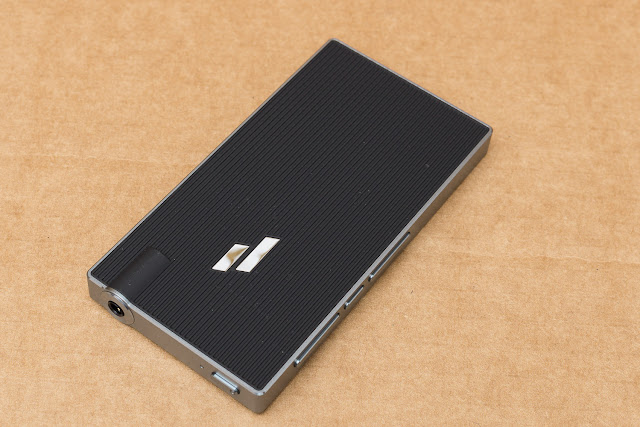
In total, one will find six physical buttons on the player, five playback and volume control buttons on the right hand side, and an on/off button with a blue LED next to it (that can be disabled in the settings and also acts as a charging indicator with red and green colours) located at the top.

There is a micro SD slot on the player’s left hand side, along with a micro USB port to charge the Plenue J and for data connection.
The serial number can be found on the bottom.
Pushing the buttons is easy, and they are also quite easy to find.
- - -
64 GB of memory are already built into the player, and the total storage is expandable through a micro SD slot.
Unfortunately, just like the
Plenue D, the Plenue J only accepts micro SD cards that are FAT32-formatted, and has got an upper limit of 128 GB, which is a bit sad since it’s late 2017 after all and since the Plenue J is not a cheap < $100 budget Player. ExFAT support and more than 128 GB of possible micro SD storage should have been possible these days.
Apart from a 3.5 mm headphone output socket, you will not find any line outputs or digital outputs – the Plenue J is a pure standalone digital audio player. And I personally really get that approach – it doesn’t want to be complicated, it doesn’t want to have too many confusing output sockets; all it needs is just a headphone output.
If you are looking for a pure line out to connect an external headphone amplifier, or if you are looking for a digital USB, COAX or SPDIF output to connect an external DAC, look elsewhere. The Plenue J is a compact portable audio player made just for playing music, and it is this simplicity that it delivers and what it’s good at.
The Screen:
The touchscreen’s LCD panel measures 2.8 inches with a resolution of 240 x 320 pixels. It is undeniably a bit pixelated for modern standards where smartphones often have a higher screen resolution and ppi rate than computer and TV monitors, but it’s still okay for an audio player.
Viewing angle stability is still rather good, and the touchscreen is responsive.
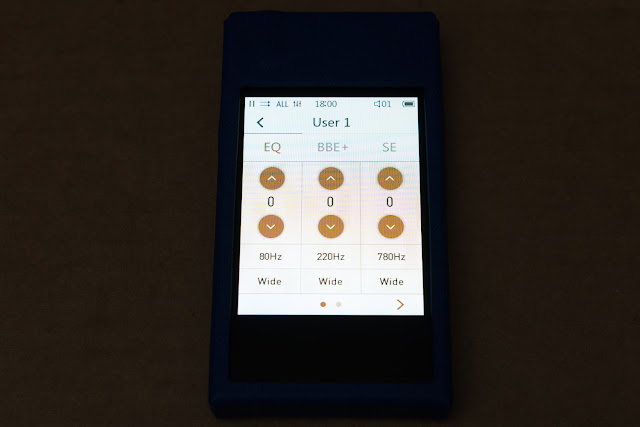 Volume Control:
Volume Control:
The Plenue J features 100 digital volume steps, with a scaling of 0.5 dB per step over the entire adjustment range, which is something that I really appreciate, as it means that there are no sudden jumps and that no matter if being in the lower or higher range, one can always find a comfortable listening level without having the desire of one or two additional steps between two volume positions as it would be the case with some other audio players that often have got a less fine scaling of the volume control in the lower ranges.
The only thing that I would
personally really like to see, as someone who usually listens at very low levels (lower than most other people), which was also already the case with the
Plenue D, is a lower lowest possible volume setting (or additional gain mode for extremely sensitive in-ears) when listening with sensitive in-ears. This could be either achieved by adding more volume steps (preferably 256 in total, as
iBasso does it with the DX90 and some of their other players), or as I said with an additional gain setting for sensitive in-ears. I am definitely more the exception than the norm in this regard though, but a lower lowest possible volume really wouldn’t hurt anyone.
Operation, User Interface:
If you are familiar with
Cowon’s more recent audio players, there won’t be anything too unexpected in the Plenue J’s graphic user interface. If you are coming from a higher-end recent Cowon device, you will definitely find the interface familiar, but with reduced features.
Firmware Version 1.00:
The UI is divided into three main sections – the music library, the music playback screen and the settings. Everything is also nicely explained in the manual that can be found on the player’s internal memory.
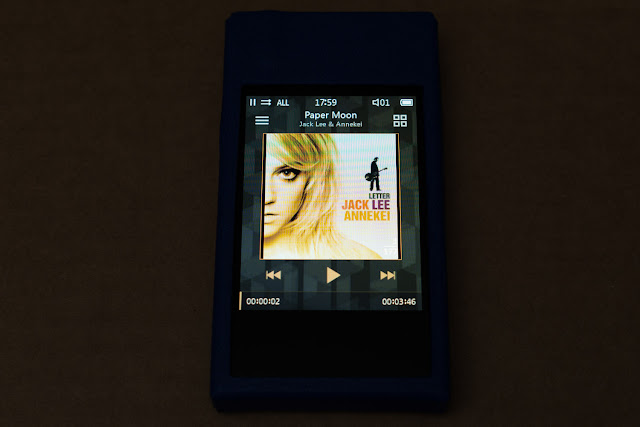
On the main playing screen, the album cover art takes up the most space and sits right in the centre. In the upper section is the status bar with information about the set playback (order, shuffle etc.), the EQ pre-set, time, volume information and battery status.
Directly below, there are virtual buttons to get to the music library or to access the quick settings overlay that lets you choose from two different player themes (“skins”), change the skip and seek settings, control the playback order, get to the advanced settings, access your favourites (yes, favourites can be set and playlists can be created and managed directly on the player), change between the JetEffect pre-sets, play a specific part of the song in a loop, or to access a “CoverFlow”-like display of your albums.
Below are three virtual playback control buttons, a track counter overlay on the album cover, and a seek/progress bar at the bottom of the screen.
Song and artist information are displayed in the screen’s upper section, right between the library and settings shortcut buttons.
Clicking on the album cover, you get to a different screen that displays the album cover art in a larger scale and shows some more advanced track information.
Clicking the small “i” icon in the lower right corner, one can see the entire track information.
Swiping to the left and right on the playing screen also skips songs in addition to the virtual and physical playback control buttons.
- - -
Tapping the list-like icon in the upper left corner, one will get to the music library.
In library view, there are a few different tiles that lead to the folder browser, artists view, album view, all songs, user-manageable favourite lists/playlists, genre view, year view, music sorted by the date it was added to the player and last but not least playlists.
Like the vast majority of audio players, the Plenue J doesn’t read the “Album Artist” tag but builds the library based on the “Artist” tag, however this is no issue at all since the folder browser is very good and since there is a very handy icon in the upper right corner that accesses a search feature with a pop-up on-screen keyboard that searches all folders as well as the database for matches, wherefore the lack of an “Album Artist” sorting won’t bother anyone who needs this feature since it can be replaced by using the search feature that is much more advanced and in some cases probably also quicker to use to find an album or artist in a long list anyway. And having this search feature with a nicely responsive keyboard implemented is a huge plus anyway, at least from my point of view.
Depending on the view in the library, the library options icon also lets you delete files/folders, play the whole folder, and create playlists.
- - -
When on the main playing screen, tapping the icon in the upper right corner opens the quick settings overlay that I already described earlier.
Tapping the wrench symbol, the main settings open up and for example let you choose your preferred menu language, set the time, adjust the automatic display off, deactivate the LED, set a button lock, or change the channel balance.
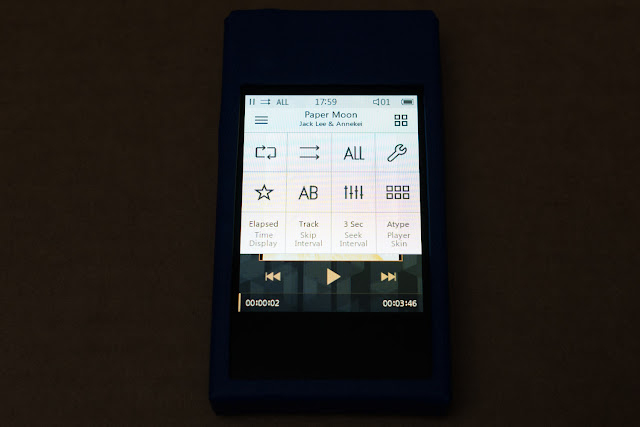
The Plenue J really does have a quite good and intuitive user interface and firmware with several options and customisation features, along with a really good music library with an extremely handy search feature as well as the ability to create and manage playlists directly on the player.
The user interface also feels mature, complete and bug-free right from the beginning and there is pretty much nothing for me left to be desired, UI-wise.
Performance:
Booting the player takes only about 6 seconds, which is really fast.
Inserting a micro SD card, the player will of course perform a database update, however it doesn’t take much time.
While touch responsiveness is good, UI and navigation speed are not like a modern smartphone’s, but unlike what I feared, they aren’t nearly as laggy as the
Plenue D’s at the time when I owned it. Overall I would definitely call the Plenue J “fluid” in terms of responsiveness, which is quite a relief.
Battery Life:
One of the player’s core strengths is its battery life.
Unfortunately I wasn’t able to run a controlled environment, lab-grade battery test this time with the Plenue J, and cannot provide an exact number of how many hours its battery lasts on a single charge, apart from the official Cowon specs.
It definitely lasted more than a week on a single charge though, actually probably a bit closer to two weeks of regular playback time, with on average more than four hours of intense use and playing in the background for a battery test (playlist with a mix of around 50% CD format files (FLAC, 16 bit, 44.1 kHz) and 50% MP3 files (320 kbps)).
Probably not 50 hours, which I think would still be possible to come close to with MP3-only playback, but most likely still fourty-ish hours or something close to that.
Sound:
Needless to say, the JetEffect settings were disabled in the following few paragraphs.
Frequency Response, Output Impedance:
One of the most basic and fundamental things an audio player should have is a flat unloaded frequency response in the important range of 20 to 20000 Hz. While it is anything but sorcery to achieve this in modern days, some (however mainly inexpensive and rather no-name) audio players still fail to achieve this very basic thing.
Let’s see how the Plenue J performs in this regard:
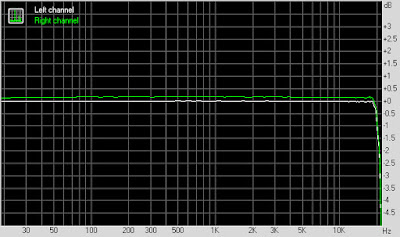
As it could be expected, the raw and unloaded frequency response is flat and therefore just exactly the way it should be.
- - -
Even when having a flat frequency response without load or with a simple load (such as a headphone that has got the same impedance over its entire frequency response), things are getting quite a bit more difficult with most multi-driver in-ears that have got more than just one driver and a crossover circuit that causes the in-ears’ resistance to vary along with their frequency response.
If the audio player’s headphone output doesn’t have a low output impedance, the in-ears’ frequency response and therefore heard tonality will be skewed and they will (depending on the player’s output impedance and the in-ears’ specific impedance response) sound more or less different compared to when driven by an audio player that has got a low output impedance.
To maintain an unaltered sound even with low impedance multi-driver in-ears, it is therefore best to have an audio player that has got an output impedance of less than 1 Ohm.
This is what the
Cowon Plenue J puts out when connecting a critical, low impedance multi-driver in-ear to its single-ended output:
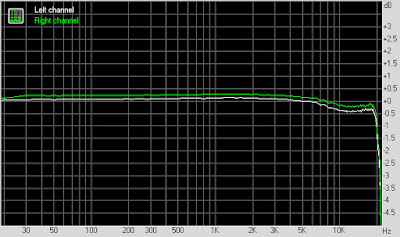
The connected load was my
Ultimate Ears Triple.Fi 10, an in-ear that is among the more source-picky species of its kind and changes its sound rapidly as the player’s output impedance climbs. I therefore pretty much always use it for measuring the frequency deviation compared to a simple load. Based on this, the output impedance can be calculated.
The measured deviation in combination with the Cowon is still rather small and can be calculated to be below 0.5 Ohms, which is a really good value and proves that the player can drive any multi-driver in-ear without altering its sound unlike players that have a rather high/higher output impedance. This also backs up Cowon’s specs that state 0.5 Ohms, too.
So if you were wondering whether or not the Plenue J has got a very low and multi-driver-friendly output impedance, I can confidently tell you that it does.
Hiss:
As someone who is quite sensitive to hearing hiss when it is present and as someone who is also using many sensitive and some very sensitive in-ears such as the
Shure SE846,
Ostry KC06A or
Pai Audio MR3, three models that are real “hiss-magnets”, having an audio player with as little audible hiss as possible has always been an important thing for me. The destination of perfection, a hiss-free audio player in combination with super sensitive in-ears, was what I could reach with my
iBasso DX90, the
Plenue 2, as well as the
Luxury & Precision L3 and
L3 Pro, though the L & P players don’t have the ideal output impedance for every kind of in-ear.
Using my Shure SE846, Pai Audio MR3 and the Ostry KC06A, I am happy to report that the Plenue J, just as the
Plenue D, is among the better players when it comes to having little to no hiss, albeit not entirely hiss-free with extremely sensitive in-ears.
It isn’t as quiet as the iBasso DX90,
DX200 or Cowon’s Plenue 2, but outputs only a relatively little amount of hiss using super sensitive in-ears.
Using still very sensitive but not extremely sensitive in-ears, such as the
Ultimate Ears Triple.Fi 10, hiss becomes practically inaudible.
Subjective Perception of Transparency, Precision & Soundstage:
Now to the rather subjective part of my review. My opinion and experience regarding the perceived “character” and “transparency” of source devices and amplifiers is this one: there can be an existing audible difference between various devices, but it should definitely not be overrated – simply because the basic character of a headphone won’t be changed completely (if the circuit follows a clean design philosophy and the output is load-stable), but sometimes rather slightly “shaped” and is usually very subtle in many cases, and is (in most cases) just slightly present (if even there) and not “huge” or like “totally different classes” or “night and day”.
I am not a fan of exaggerations and hyperboles here because as long as the objectifyable parameters of an audio player are neutral and not too shabby (loaded frequency response, distortion, crosstalk, dynamic range, noise, …), the audible difference, if there is any, will be quite small at best if two devices are compared with proper volume matching that cannot be done by ear but only with instruments, since even small differences in loudness can be perceived as a technical advantage by our ear and brain.
A more detailed, German article written by me concerning the “audible difference between comparable audio devices, if there is any, can be found here:
http://kopfhoerer-lounge.blogspot.de/2016/04/Eigenklang.html
So let’s go on with my subjective impressions and observations (for this critical listening, I mainly used my
UERM,
Shure SE846 and
Pai Audio MR3, as well as the
Ostry KC06A,
UERR to-go and
NocturnaL Audio Atlantis. I also used more headphones and in-ears from different price and performance ranges for listening but more for personal enjoyment than for the sake of critical listening and comparisons):
If you regard the
iBasso DX90 as slightly “aggressive” and “digital”, then you will find the Plenue J to sound “smooth”/a bit ”lush” and “analogue”. Both players still have a quite neutral timbre subjectively, and they do objectively anyway, but they are definitely not similar when comparing them head-to-head using good in-ears.
One cannot solely contribute this to only the DAC or only the amplification section though, but those small differences are a result of how the individual components are implemented.
The signal is clean and detailed, which is thanks to the good signal-to-noise-ratio the Cowon has, something that goes for most of their digital audio players.
Seldom, audio players seem to have a slightly soft bass response using very sensitive in-ears or some planar magnetic headphones, which may or may not be caused by some hissing in the lower frequency ranges. This is also absent on the Plenue J when I am using sensitive multi-BA in-ears or my
Audeze LCD-X.
To my ears, the Cowon’s transparency seems to be relatively on-par with my iBasso DX90 and the
Plenue M2, and slightly behind the
Plenue 2 and
iBasso DX200.
While I usually cannot hear a reproducible difference in terms of soundstage reproduction among various audio sources when using full-sized headphones, there can be a slight difference to my ears when using sensitive in-ears with a three-dimensional soundstage on various sources (that have an output impedance that is low enough so that it doesn’t change the in-ears’ frequency response).
To my ears, for example using the
UERR and my
SE846 for this, what I hear from the Plenue J is a quite normal, circular soundstage. Not as wide as the
DX90’s but not as flat either and therefore with a bit more front projection.
- - -
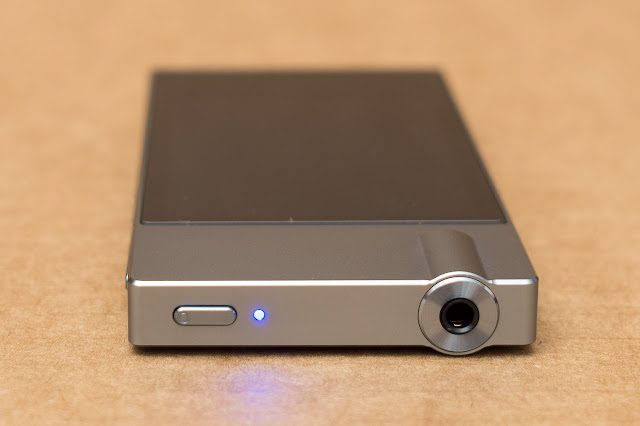
So does the Plenue J deliver a clean sound? Yes, yes it does. It has got what I expect and demand from every good audio player – transparency, cleanness, a neutral frequency response, good SNR performance, and a low output impedance.
Gapless Playback:
Playing lossless CD-standard FLAC files, gapless playback fortunately works perfectly and there is no gap, silence, hiccup or whatsoever between two tracks that have been recorded/cut/mastered with the intention of being played back without any audible gap between them.
JetEffect 5 DSP and Equalizer:
A Cowon DAP wouldn’t be complete without JetEffect, would it?
JetEffect has always been a very easy to use and powerful sound manipulation feature built into Cowon’s audio players. JetEffect’s 5th generation is built into the
Plenue J.
Of course, JetEffect is disabled by default but can be easily enabled in the overlaid quick settings and further adjusted in the main settings.
Besides many various pre-sets made by Cowon and up to four user-configurable pre-sets (that can however not be renamed), one of its features is a semi-parametric 5-band equalizer that lets you select from four frequencies and three bandwidths per band.
Even more powerful are the various DSP settings such as “BBE”, a variable loudness with built-in resampler, “3D Surround”, a virtual soundstage enhancer, or various adjustable reverb characteristics that allow the user to tailor the sound to their preferences in real time and without any added audible distortions. Each parameter’s intensity is adjustable in 10 steps.
Quite nice is also that most of Cowon’s fixed pre-sets are very well usable and don’t appear out of place.
- - -
To round out this brief summary of Cowon’s JetEffect 5, let’s see what the equalizer and DSP settings actually do:
As mentioned, there are 5 total frequency bands built into the semi-parametric equalizer. Each band can be adjusted in frequency and bandwidth, with four respectively three settings being available for both parameters:
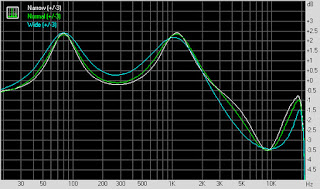
Then there is BBE, an adjustable loudness with built-in resampler:
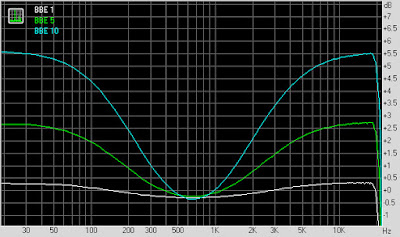
Lastly, from what alters the frequency response, there is Mach3Bass, a variable bass boost (please note that the y-scale of this graph is different to the others in order to fit both curves):

Mach3Bass is a very clean bass boost for the lower midbass (unfortunately it doesn’t affect the real sub-bass below 40 Hz).
By the way, all settings can of course be combined.
- - - - - - - - -
Comparison with the iBasso DX90:
Both are compact, portable digital audio players. The Cowon’s housing consists of metal to a higher degree, but both players appear well-build and premium, the Plenue J probably even more so.
A silicone case, screen protector and COAX cable were part of the iBasso’s
standard delivery content though.
The DX90 has got more outputs (digital COAX output, line out) and a USB DAC feature whereas the Plenue J is just a pure standalone audio player.
The DX90 features three gain settings and a replaceable battery, and has got the higher possible power output.
Both have a similarly precise volume scaling (0.5 dB per step over the entire range) but the DX90 has 256 steps compared to the Cowon’s 100 wherefore one can listen at much quieter levels with the iBasso when using very sensitive in-ears.
The two players have got a comparable screen quality and responsiveness (the DX90 is probably just very slightly quicker).
While the Plenue J has got 64 GB of built-in memory compared to the DX90’s 8 GB, the iBasso accepts exFAT without any problems and doesn’t have a 128 GB card limit, which leads to higher convenience and higher possible total storage.
In terms of user interface, both are intuitive and simple, but the Cowon has got the advantage of a really nice search feature with a very responsive software keyboard overlay, the JetEffect suite, and a track counter on the playing screen. Both players have got a really good folder browser.
The DX90 has got the advantage of performing even better in terms of being hiss-free, since it is basically quiet with extremely sensitive in-ears whereas there is still some slight audible hiss with super sensitive in-ears coming from the Cowon that is pretty good, but not perfect in this regard.
Both players have got a really low and perfectly multi-BA in-ear friendly output impedance.
Using in-ears, the Cowon takes on a slightly “smoother” presentation whereas the DX90 appears more “aggressive” and “digital”. It’s not a “night and day” difference though.
Also using sensitive in-ears, the DX90 renders a somewhat wider soundstage whereas the Cowon’s is more circular and therefore deeper.
In terms of “transparency”, both are quite similar, with probably a slight advantage for the DX90, sounding minimally “cleaner”.
Conclusion:
The
Cowon Plenue J is a compact, sleek, well-built, premium and elegant digital audio player that really is just this, a pure standalone player designed for mainly portable headphones and in-ears. Its sonic qualities are good, it has got a low and multi-BA in-ear-friendly output impedance, and is definitely among the better performers when it comes to outputting only little hiss with extremely sensitive in-ears.
The user interface is, as always when we speak about Cowon, intuitive, bug-free and easy to use, and has got nice features such as a really good folder browser, the ability to create and manage playlists on the go, and a very nifty search feature. Responsiveness and speed are good, too, although a bit less instant when comparing the Plenue J to a modern high-end smartphone.
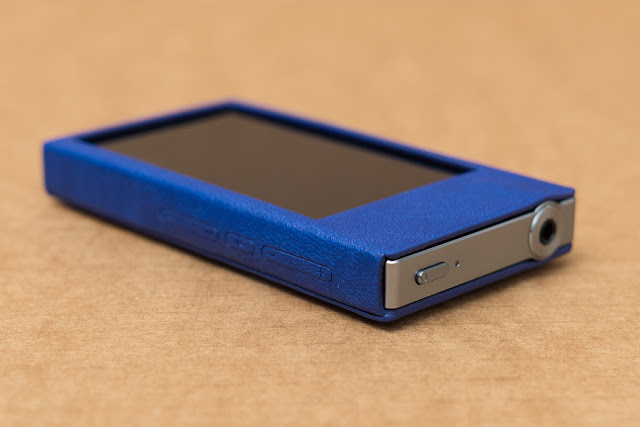
The only thing that isn’t so nice about the player, given that it’s late 2017, is that it only accepts FAT32-supported micro SD cards and has got an upper limit of
128 GB, just like the
Plenue D. Other than that, it is a great player if you are looking for something small, portable, don’t want to use too inefficient headphones, and don’t need any digital outputs, a line out, a high resolution screen or Bluetooth.
The only other thing that I would
personally really like to see implemented to the player is a lower lowest possible volume, but I know that I am quite in the minority with this request.















